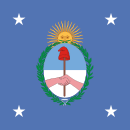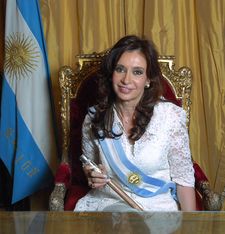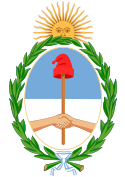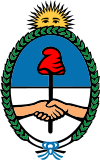President of Argentina
|
||||||||||||||
|
||||||||||||||
The President of Argentina (full title: President of the Argentine Nation, Spanish: Presidente de la Nación Argentina) is the head of state of Argentina. Under the national Constitution, the President is also the chief executive of the federal government and Commander-in-Chief of the armed forces.
Through Argentine history, the office of the Head of State has undergone many changes, both in its title as in its features and powers. The current President is Cristina Fernández de Kirchner, who was sworn in on 10 December 2007.
Contents |
Features of the office
Requirements
Section 90 of the Argentine Constitution establishes the requirements for becoming President. The President must be a natural-born citizen of the country, or have been born to Argentine citizens if born abroad. The President must also meet the same requirements as a Senator.
Sections 97 and 98 discuss the electoral requirements. The winning candidate's party must receive either more than 45 percent of the overall vote (Section 97) or at least 40 percent of the overall vote and be more than 10 percent ahead of the candidate with the second-highest percentage (Section 98).
Term duration
Under the 1994 constitutional amendment, the President serves for four years, with a possibility of reelection for one more term.
Under the constitution of 1853, the President served for six years, with no possibility of consecutive reelection. In 1949, reelection for an indefinite number of terms was allowed (and disabled in 1957). After the 1966 military coup, the rulers promulgated a law establishing terms of four years, terms which were never completed because of political instability.
Presidential airplanes
The most famous presidential airplane, known as "Tango 01" (by analogy with U.S. Air Force One), owes its name to the denomination of T (pronounced tango in the NATO alphabet) for Transport, which creates an interesting word-game for the Argentine classical Tango music. The presidential helicopter is the usual means of transport between the Quinta de Olivos and the Casa Rosada.
History of the Office of Head of State
Pre-autonomous government
The origins of Argentina as a nation can be traced to 1776, when it was separated by the Spanish King from the existing Viceroyalty of Peru, creating the new Viceroyalty of the Río de la Plata. The Head of State continued to be the King, but was represented locally by the Viceroy. These Viceroys were seldom natives of the country.
Early autonomous government
By the May Revolution of May 25 1810, the first Argentine autonomous government, known as the Primera Junta, was formed in Buenos Aires. It was later known as the Junta Grande when representatives from the provinces joined. These early attempts of self-government where succeeded by two Triumvirates and, although the first juntas had presidents, the King of Spain was still regarded as Head of State (as independence had not yet been declared), and the executive power was not still in the hands of a single person.
This power was vested in one man when the position of Supreme Director was created by the 1813 National Assembly. The Supreme Directors became Heads of State after Independence was declared on 9 July 1816, but there were not yet truly a presidential system.
The Constitution of 1819
In 1819, Congress declared Independence and composed a Constitution. This established an executive figure, named Supreme Director, who was vested with presidential powers. This constitution gave the Supreme Director the power of appointing Governors of the provinces. Due to political circumstances, this constitution never came into force, and the central power was dissolved, leaving the country a federation of provinces.
The Constitution of 1826
A new constitution was drafted in 1826. This constitution was the first to create a President, although this office retained the powers described in the 1819 constitution. This constitution did come into force, resulting in the election of the first President, Bernardino Rivadavia. Because of the Argentina-Brazil War, Rivadavia resigned after a short time, and the office was dissolved shortly after.
The civil war
A civil war between unitarios (unitarians, i. e. Buenos Aires centralists) and federales (federalists) ensued in the following decades. In this time, there was no central authority, and the closest to that was the Chairman of Foreign Relations, typically the Governor of the Province of Buenos Aires. The last to bear this title was Juan Manuel de Rosas, who in the last years of his governorship was elected Supreme Chief of the Confederation, gaining effective rule of the rest of the country.
The Constitution of 1853
In 1852, Rosas was deposed, and a constitutional convention was summoned. This constitution, still in force, established a national federal government, with the office of the President. The term was fixed as six years, with no possibility of reelection. The first elected President under the constitution was Justo José de Urquiza. After a brief interruption in 1860, the succession of Presidents ran smoothly into the 20th century, until it was interrupted by several coups d'état, creating a series of elected presidents mixed with de facto ones.
Military presidents
In 1930, and again in 1943, 1955, 1962, 1966 and 1976, military coups deposed elected Presidents. In 1966 and 1976, federal government was undertaken by a military junta, where power was shared by the chiefs of the armed forces. In 1962, the President of the Senate ruled, but in the other cases, a military chief assumed the title of President.
It is debatable whether these military presidents can properly be called Presidents, as there are issues with the legitimacy of their governments. The position of the current Argentine government is that military Presidents Leopoldo Fortunato Galtieri and Jorge Rafael Videla were explicitly not legitimate presidents. They, and their immediate successors were denied the right to a presidential pension after the conclusion of their terms. The status of earlier military presidents, however, remains more uncertain.
Statistics
- President elected to the most terms: Juan Perón, three terms, elected in 1946, 1951 and 1973.
- President who held office for most time: Julio Argentino Roca, for 12 years, in two terms (1880-1886 and 1898-1904).
- President who held office for most time continuously: Carlos Menem, for 10 years and 5 months, in two terms (1989-1999).
- President who held office for least time (not counting interim presidents, i.e. acting presidents who didn't take the oath): Adolfo Rodríguez Saá, for just seven days; December 23, 2001 to December 30, 2001.
- First President: Bernardino Rivadavia, 1826.
- First President under the present Constitution: Justo José de Urquiza, 1854 to 1860.
- First President born an Argentine citizen, not a Spanish subject: Bartolomé Mitre, in 1821.
- First President born in the twentieth century: Pedro Eugenio Aramburu, in 1903.
- First President elected in the twentieth century: Manuel Quintana, in 1904.
- First President elected in the twentyfirst century: Néstor Carlos Kirchner, in 2003.
- First de facto President: José Félix Uriburu, 1930.
- Last de facto President: Reynaldo Bignone, left in 1983.
- First female President: Isabel Perón (1974-1976).
- Presidents who were father and son: Luis and Roque Sáenz Peña.
- Father who was President and son who was Vice-President: Julio Argentino Roca and Julio Argentino Roca, Jr.
- Presidents who were brothers-in-law: Julio A. Roca and Miguel Juárez Celman
- Presidents who were husband and wife: Juan Perón and Isabel Perón (last period of Juan Perón, 1973-1974). Néstor Kirchner and Cristina Fernández de Kirchner.
- First elected female President: Cristina Fernández de Kirchner, in 2007.
- Presidents who died in office: Manuel Quintana (1906), Roque Sáenz Peña (1914) and Juan Perón (1974).
- Presidents who were assassinated: Justo José de Urquiza (1870) and Pedro Eugenio Aramburu (1970), both after concluding their terms.
- President with the highest longevity: Edelmiro Farrell, who died in 1980 at age 93.
- President with the least longevity: Nicolás Avellaneda, who died in 1885 at age 48.
- Shortest period with the highest number of consecutive presidents: 13 days (December 21, 2001 to January 2, 2002), during which five presidents were in office: Fernando de la Rúa (Resigned), Ramón Puerta (Interim), Adolfo Rodríguez Saá (Resigned), Eduardo Oscar Camaño (Interim), and Eduardo Alberto Duhalde (held office until next election, in 2003).
The office of Vice-President
In the constitution of 1853, the office of Vice-President was established for the purpose of providing for succession in an unfinished term. In the amendment of 1994, the Vice-President, as in other countries, was given the additional title of President of the Senate, making his role a more legislative than executive one, with the power to vote in the case of a tie in the assembly.
|
||||||||||||||||
|
||||||||||||||||||||||||||||||||||||||||||||||||||||||||
|
|||||
|
||||||||
See also
- List of Presidents of Argentina
- List of Vice-Presidents of Argentina
- History of Argentina
- Politics of Argentina
External links
- (Spanish) Official presidential website



